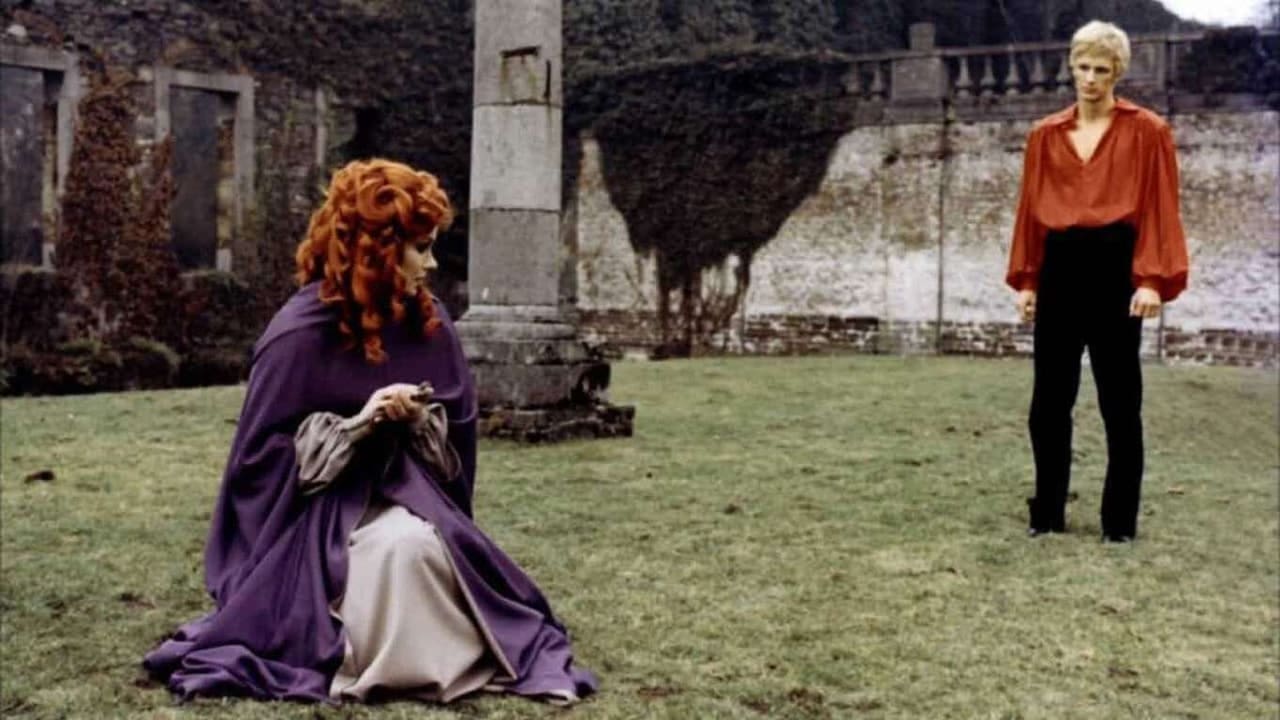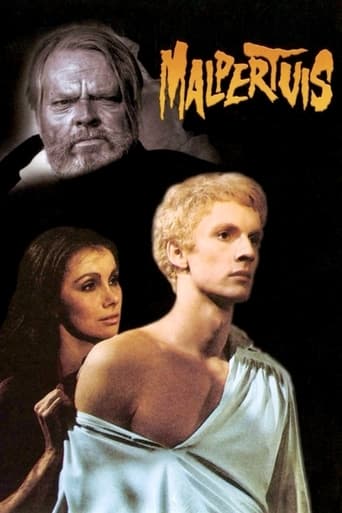

Malpertuis starts as a sailor named Jan (Mathieu Carriere) arrives at his home port only to discover his old house has collapsed, he ends up in a seedy bar where a fight breaks out & he is knocked unconscious. When he comes round Jan finds himself being tended to by his sister Nancy (Susan Hampshire) in his Uncle Quentin Cassavius' (Orson Welles) imposing old house called Malpertuis, they are also joined by various other family members & obscure relatives as Cassavius is not far from death & he has ordered a reading of his will. The will states that his immense fortune will be split equally but the inheritors can never leave the grounds of Malpertuis ever again which sounds a bit harsh to me but there you go, anyway it becomes apparent to Jan that all is not right at Malpertuis & that it's hiding some bizarre secrets that Jan finds himself in the center of...This French, Belgium & German co-production was directed by Harry Kumel & didn't do much for me but that could be down to other factors besides the film at hand, you see apparently there's a long 2 hour odd version of Malpertuis & shorter cut down version & since the one I watched yesterday ran for less than 90 minutes I think it's safe to assume I'm missing out on a lot so maybe you should bear that in mind although what the extra footage is & whether it would have improved my viewing experience I don't know. The slightly slow going script by Jean Ferry was based on a novel by Jean Ray & has a certain loose strange bizarre quality to it, while it's an odd film for sure I have to say I always knew what was going on & it's not abstract or weird in that sense but weird in the sense of what's happening on screen. Who was the supposed killer? Is this answered in the longer version? Were little stitched together people really running around in the attic? Again, is this made clear in the longer version? I don't know which is why I feel awkward about either praising or rubbishing the film because I'm not quite sure where the version I saw stands, going by the 90 minute cut alone I thought it was OK & nothing more although I must admit I quite liked the twist 'come out of absolute nowhere' ending which I deify anyone to see coming...Director Kumel does a good job & there are plenty of memorable scenes plus the film has a great atmosphere about it. The house itself is nice & imposing & there's some cool production design. I wouldn't call any of it particularly scary though, there's not much gore apart from a bit when an Eagle eats someone's guts & someone gets a nail through their head although it's off screen.Technically Malpertuis is good, impressive even with decent production values. Since the film was made in Dutch & dubbed into English it's hard to tell about the acting although maybe Welles spoke English during filming & he stands head & shoulders above everyone else in the cast & puts in a memorable performance for the brief screen time he gets.Malpertuis, also known as The Legend of Doom House, is an OK horror/mystery/thriller but I can't help but feel I wish I'd seen the long version because as it stands I think I'm missing out on a potentially better film. However the version I watched is the version I watched & that's all there is to it, as it stands it's a decent enough film but it didn't do much for me & I doubt I'll be in any hurry to see this 90 minute cut again anytime soon.
... View MoreI saw an english spoken version with 110m informed on the video box, but really 95min in video band. I remember, a long time ago, I saw this film in cinema with more as 110m. A lot of scenes disapeared: The face from Alecta, two times that the antiquaire appears in the film. I remember it was another end too, or maybe I'm wrong? Was ever the last scene a close of Jan's eye? Where is a complete copy of this film? It's very sad this cutting of scenes.
... View MoreThat's what the title means;or at least,that's what the priest explains to Matthieu Carrière.The subtitle is overkill and was added for commercial reasons,probably unbeknownst to the director."Doomed house" is a stupid title:are we so sure it's the story of a house? Isn't it rather the story of a mind? of a fantasy? of a folly?This poesque subtitle is not suitable for Jean Ray's world,who keeps a certain logic inside a nightmarish swarming of monsters,werewolves,Gorgons and mad scientists.Some of his obsessions surface here:the Gorgon,turning mortals into stone,the taxidermist working on alive bodies,are topics we find not only in "Malpertuis" but also in "the adventures of Harry Dickson" ,his favorite hero (he wrote dozens of stories of this detective and his pupil Tom wills)Prometheus recalls here how suffering and sadism were haunting the Belgian writer.Because Belgian,this definitely is.Kummel's closest relative is none other than his compatriot André Delvaux who quoted Jean Ray in his masterwork "un soir,un train".I urge the users who have liked "Malpertuis" to try "Un soir ,un train".It's the same kind of atmosphere,simply it's more mastered,the emotional power -cruelly lacking in Kummel's work- is increased tenfold ."Malpertuis" has a dream of a cast:Orson Welles-in a short part,but he makes every of his word count-,Matthieu Carrière ,"Der Junge Törless" wunderkind,Susan Hampshire,Two Chabrol favorites (Michel Bouquet and Jean-Pierre Cassel,both in "la rupture" some months before),and,most amazing thing,French singer Sylvie Vartan and in a cameo(uncredited) her then-husband ,Johnny Hallyday.The plot may be hard to swallow for horror buffs.It's a film "à tiroirs",and the ending has in store at least three unexpected twists.The last picture leaves the spectator bewildered.Hampshire and Carrière seem unreal,and the world that surrounds them is no longer a world in ruins,but a world that forgot he's in ruins.And what kind of world is it?
... View MoreBased on the novel by Jean Ray (the so-called "Belgian Poe"), "Malpertuis" begins with Jan, a young sailor, being summoned with a motley company of acquaintances and family to the death bed of his mysterious Uncle Cassave. Cassave soon dies, leaving his considerable fortune to the dozen or so people he has summoned. However, there are stiff terms attached to his gift: The inheritors must all live for the rest of their lives at Malpertuis, Cassave's mansion. Jan soon realizes there is something amiss at Malpertuis (a name meaning either "house of evil" or "house of cunning"). There is something odd in the attic, in the labyrinthine hallways, and in the surrounding wood. There is something even stranger about Malpertuis' other inhabitants: the mad hermit Lampernisse who haunts the mansion's dark corridors, the coy and beautiful Euryale who will not look anyone in the face, and the diabolic taxidermist Philarete, to name only a few. When the secret of Malpertuis is finally brought to light among this bizarre cast of characters, the mansion erupts into a seething cauldron of terror, and both heaven and earth seem to collapse around Jan.While fans of Jean Ray's novel will find the story much changed, the film is visually engaging at the very least, and the casting is excellent, for the most part. Orson Welles plays the dying Uncle Cassave, delivering the second performance of his career as a large man stuck in a very large bed (the other performance being, of course, in his adaptation of Kafka's "The Trial"). Susan Hampshire gives an admirable performance in four different roles--excellently well disguised and made-over in each--as Euryale, Nancy, Alice, and a nurse. The sets are extraordinary, filling the screen with an unending stream of vivid detail. Also, the film's cinematography is often both aggressive and intelligently creative, employing just the sort of unpredictable perspective necessary to portray the mansion's mystifying interior.Disappointments with the film begin small. Jean-Pierre Cassel as Lampernisse does not look the part. Instead of a tall, shadowy, aged-but-ageless, and profoundly mad hermit, he looks like a leper who has wandered off the set of "Ben-Hur." Accompanying Lampernisse is the laughable, high-pitched babble of the "creatures in the attic." In these rare instances, the filmmakers miss by a wide margin the texture of Ray's novel. At other times the film slightly underplays or rushes some of the book's strongest scenes. The one serious offense, though, is the film's ending; the muddled chaos here is a poor substitute for Ray's synchronized anarchy.This is not to say that the film loses itself completely. The strength of the first hour and more cannot be entirely undermined by the ending. The inspired cinematography and many of the sets, performances, and special effects are truly exceptional. The scenes with little, crazed, mousy Philarete and his morbid workroom are reason enough for the film to exist. Subtlety and humor are here as well, perhaps best represented in the recurring static shot of the inheritors occupying themselves in Malpertuis' small drawing room.
... View More